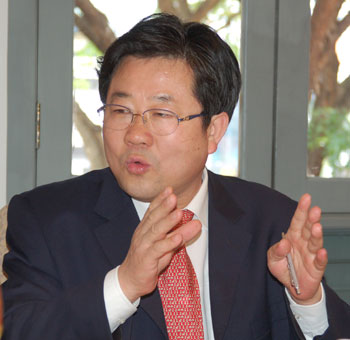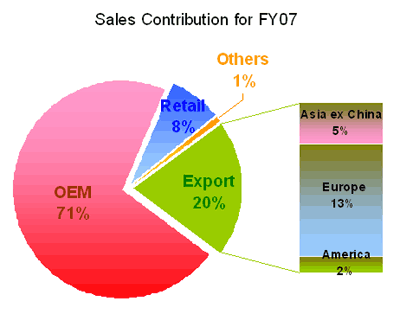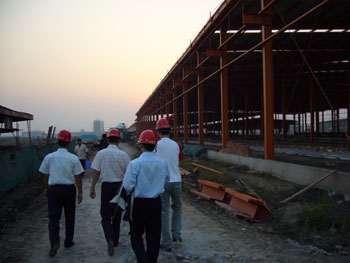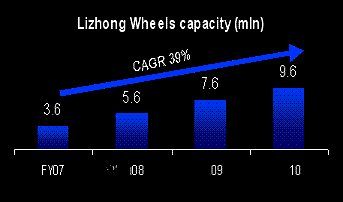
NINE MILLION new vehicles were added to China’s roads by domestic car makers in 2007, amounting to market potential for 44 million wheels just from new vehicle demand.
72% of these new vehicles are passenger cars, which absorbed the bulk of the 3.4 million wheels produced by SGX-listed Lizhong Wheel last year. The remaining new vehicles are trucks and vans.
Lizhong Wheel was formerly known as China Wheel Holdings Ltd. The company changed its name in January 2008 after another company registered as "China Wheel" announced listing plans on the Hong Kong Stock Exchange.
The new name reinforces the company's brand presence as it is also the trading brand name and the name of its main operating subsidiary.
FY07 sales growth for Lizhong Wheel, one of China’s leading aluminum alloy wheel makers, at 19.1%, was largely in line with the 21.8% growth of unit vehicle sales in China last year.
Lizhong Wheel’s FY07 sales rose to Rmb 905.4 million. Gross margins widened 2.6 percentage points to 17.8%, resulting in gross profit growth of 39.1%, which is higher relative to sales growth.
”We sold more wheels with higher margins,” says executive chairman Zang Ligen in an interview with NextInsight.
50-60 new designs are launched every year. New prototypes introduced in FY07 included lighter and larger wheels for high-end sedans and sports utility vehicles.
”Lighter wheels will be more popular with the push for fuel-efficient vehicles,” says Mr Zang.
“Flow-formed” wheels weigh 15% less and lend more stability to vehicles as their diameters are up to 20% wider. The increase in stability is significant, considering that relative mass of a vehicle’s wheels is less than 5% of the weight it supports.
“Flow-forming”, an ultra high precision technology, also allows more aesthetically flexible designs to be produced. So far, 2 customers have placed orders for the flow-formed wheels. Lizhong Wheel is the first in China with a complete “flow-forming” production line.
From a production perspective, lighter wheels cost less to produce because 15% less alloy metal is required. The wider diameter also makes it easier to fashion the wheel’s façade.
Sales shift toward China

China accounts for 10% of the global vehicle market and contributed 80% to Lizhong Wheel’s FY07 sales. It is also the second largest vehicle market after North America.
Sales in China grew 29% to Rmb 721.5 million while exports fell 8% to Rmb 183.9 million for the following reasons:
1) Steady appreciation of Chinese yuan by 6.9% over 2007 to US$0.137 as at 31 December 2007
2) Drop in exports of galvanized wheels sales – the company decreased production of such wheels as costs of galvanizing materials copper and nickel rose steeply in 2007.
Furthermore, average selling prices for galvanized wheels are twice that of the normal aluminum alloy wheels.
Lizhong Wheel has 3 main distribution channels:
1) OEM: local automobile manufacturers and established wheel manufacturers
2) Export: international wheel distributors in US, Europe, Japan and South Korea
3) Aftermarket: retail sales to consumers through 40 distributors throughout China
Decentralizing production base

”Our capacity constraint will ease when phase one of our Tianjin plant adds 2 million wheels in May 2008,” says Mr Zang.
The company's Tianjin plant, scheduled to be completed in 3 phases, will be able a total of 5 million wheels. It sits on 285,000 sq m just 15 km away from leading PRC carmaker, FAW Toyota Motor’s Tianjin factory, and just 16 km away from Tianjin Xin’gang port.
The leading aluminum wheel maker is currently able to produce 3.6 million wheels a year (8% of national wheel demand from new vehicles) out of Baoding, which is near Beijing.
With FY07 net margins edging up 1.3 percentage points to 11.6%, Lizhong Wheel is maintaining its position as China’s most efficient wheel maker. "Leadership in operational efficiency allows us to adjust pricing to create demand for our additional wheels, should there be a need," says Mr Zang.
Construction of buildings for phases two and three of the Tianjin plant, which add another 3 million wheels, will take place simultaneously, says Mr Zang. Building the facade of phases two and three together may save the company up to 5%-10% in construction cost, he figures.

The company announced in December 2007 its latest plans to add capacity - a JV in Inner Mongolia for a plant with capacity of 1 million wheels a year. With the latest plant, to be ready by 2Q 09, capacity will grow 2 million wheels a year until it reaches 9.6 million in 2010.
The company will pay a first and final dividend of Rmb 0.072 per share, amounting to 16% of FY07’s net profit of Rmb 106.8 million. Net profit was up 34% y-o-y.
UOB Kayhian reiterated its buy call on Lizhong Wheel yesterday, revising its target price to S$1.07. That represents about 88% potential upside to the stock's closing price of 57 cents.
Recent stories:
LIZHONG WHEEL now at only 5.5x PE for this year: Phillip Capital
CHINA WHEEL'S visionary leader







